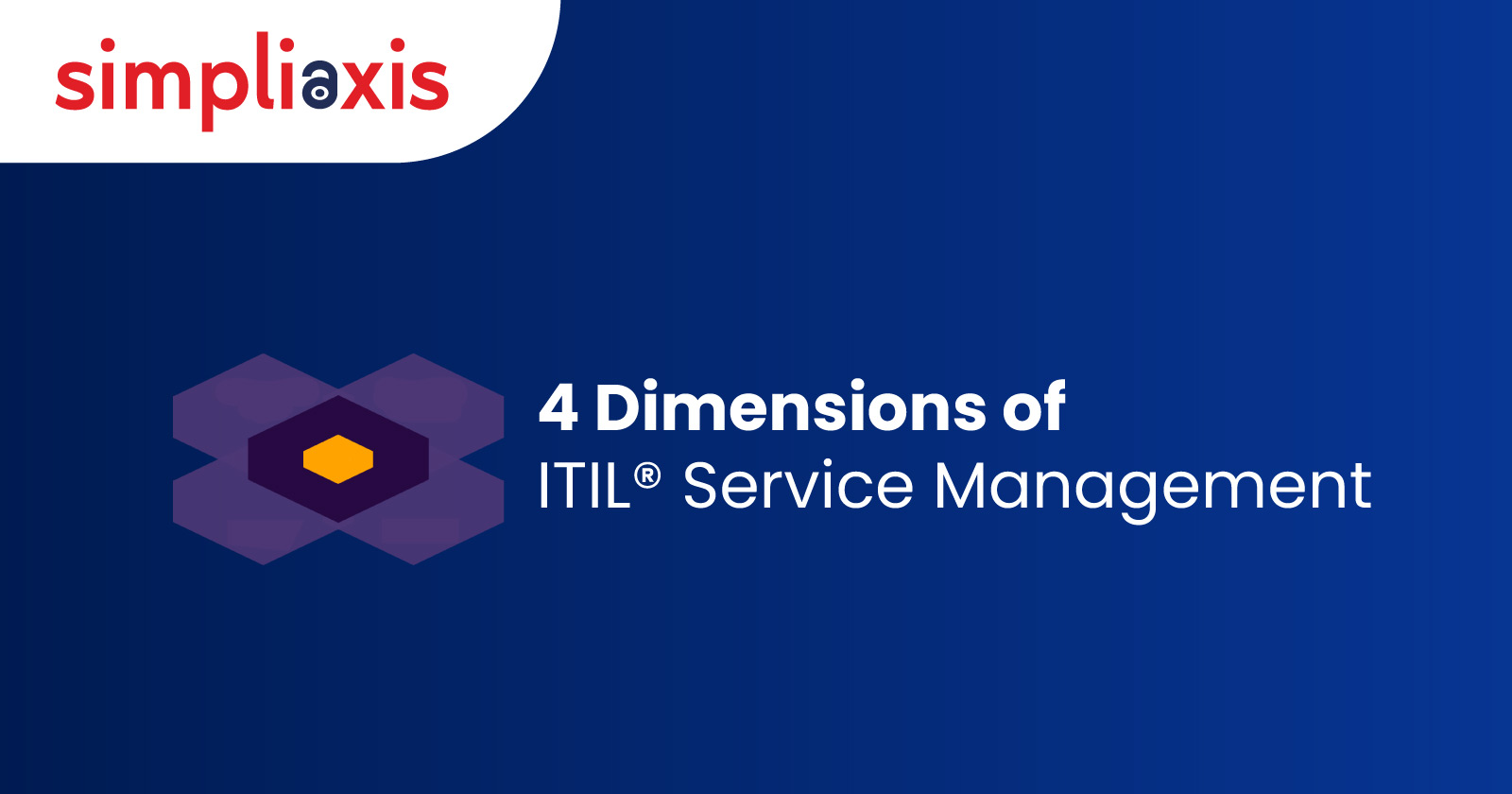The Information Technology Infrastructure Library 4 or ITIL 4 comprises the most updated set of practices and procedures of one of the world’s foremost IT Service Management frameworks. ITIL 4 has a focus on Lean-Agile and DevOps. The distribution and maintenance of various services and products need unique elements. Because no single element can provide value by itself, a comprehensive approach is required, that is, examining all dimensions when building and updating goods and services. The ITIL 4 four dimensions method is a technique for ensuring that individuals evaluate all of the elements and do not become overly fixated on one area. This article will discuss the four dimensions of service management as discussed in ITIL 4.
Four Dimensions of ITIL are:
- Organizations and People
- Information and Technology
- Partners and Suppliers
- Value Streams and Processes
Organizations and People
The structure of the organization and the people associated with it primarily strengthen the organization's goal and purpose. The structure, scale, and complexities related to an organization are changing as a result of the changing environment, technologies, and personal capabilities. Organizational structure adapts to meet the changing needs of the company. Roles and duties, control and accountability, coordination and communication, technological support, procedures, practices, and regulations all lead to the enhancement of an organization's structure.
Modern enterprises are becoming increasingly technologically capable, necessitating the employment of individuals with technical knowledge. Nevertheless, elements of their unique characteristics like the capacity to communicate, cooperate, manage, and so on are also significant considerations to consider. An officially constituted structure for an organization may be incapable of providing the essential quality and efficiency. It necessitates continuous advancements, with a dynamic culture that remains aligned with corporate objectives, development of skills and capability development, employee motivation, and so on.
The design, delivery, and improvement of services are all tied to the Organizational and People dimensions. To enhance these qualities, every member of the organization must understand the organization's goals and how they fit into those goals. Organizations are frequently restructured in order to realize the benefits of Agile, Lean, and DevOps approaches. In order to break down barriers and promote more efficient cooperation, organizations are increasingly developing cross-functional or product teams. None of this is possible without first grasping the magnitude of culture's effect on both organizations and individuals. The individuals must be the center of attention here! Shared values, teamwork, and trust are the foundations of healthy company culture.
Also, Check:ITIL 4 Best Practices
Information and Technology
The term "information" pertains to processing data that has a particular context. For instance, an event log for a specific time (ex: a month) will be utilized to obtain information that will be analyzed to make logical sense out of it, such as how many events were recorded, resolved, outstanding, and so on. Information leads to awareness, which is required for service management and recognizing the tech used to generate and provide services.
Information is developed and maintained for a specific IT service. It is further utilized during the construction, delivery, and support processes. The use of technology for processing information and data is critical in today's corporate context in order to fulfill the ever-changing requirements of consumers and users. The incorporation of technology increases the organization's operational efficiency. The implementation of technology is evident in knowledge management, trend analysis, process & workflow management, automation, developing communication management systems, and cooperation among geographically distant cooperation.
The fact that these four aspects of service management relate not just to management but also to the services being managed is common to all of them. Service management's Information and Technology component is no exception. It covers the necessary technology as well as the necessary expertise to administer services. The linkages between different components of the service system of values, such as the inputs and outputs of activities and practices, should be emphasized here. Organizations must seek out and use technologies that have become standard practice if they do not want to fall behind. The information architecture of services should be fully understood and regularly analyzed for optimization in order to ensure the usage of developing technologies. Availability, security, and compliance are all ensured by information criteria. Information management is the key way of enabling consumer value for most services.
Partners and Suppliers
The partner & suppliers component of ITIL v4 discusses the significance of collaborating with partners and suppliers to guarantee the effectiveness of service management as well as its interplay. It is clear from the earlier depicted service relationship model.
Partners and suppliers will be engaged throughout the entire value chain, that is, in the design, development, delivery, support, and continuous improvement of the product or services. The relationship created by an organization with its partner and supplier will be to obtain a certain service or product that would support the company's service aim and value creation for its customers.
The connection between an organization and other organizations participating in service design, development, and delivery falls under this dimension. This dimension also covers service support and continuous improvement. This dimension must include contracts and agreements since it is based on interactions with other organizations. The plan for how an organization will harness the participation of suppliers in achieving its overall service management strategy is defined by its supplier strategy.
One strategy that businesses may use to approach the partners and suppliers dimension is integration and management, which entails forming an integrator who will build service connections for successful cooperation and interaction. The decision to include the correct partners and suppliers must be taken with caution. The culture, as well as the partner's or supplier's capacity to comprehend and connect with the service parameters, is crucial to effective cooperation with collective gain.
Value Streams and Processes
"A value stream is a collection of activities that a firm employs to develop and distribute products and services to a user," according to the definition. A value stream is a collection of the value chain operations of a business." Value streams and processes are primarily concerned with ensuring the interconnection and coordination of numerous activities and pieces that improve the firm's value production. This aspect is mainly concerned with how the company has organized its operations or processes, as well as how it facilitates and assures value generation for all stakeholders.
A firm's product or service should be structured while keeping in mind the value stream. One must have a coherent sense of what and how a product or service has been delivered and how to improve things continuously. This necessitates the recognition and comprehension of the value stream, as well as the ability to see the big picture. Furthermore, organizations should constantly examine and comprehend the current status of the organization's situations, limits, waste producers, and so on. It might include people, operations, goods, partners/suppliers, data, and so on.
Furthermore, it is essential to comprehend how contemporary technology may be used to increase the efficiency and quality of the company as well as the customer experience.
Value streams and processes are dimensions that apply to the entire service value system and are associated with how the various elements of the organization work together to enable value production in an integrated and coordinated manner. Value streams and processes are groups of actions that have been specified. Value streams are intentionally basic enough to capture the information flow and materials and give a macro-level picture of operations. This high-level (macro) perspective makes it easy to see waste and, even better, to remedy it. A process is a lower-level view that specifies the sequence of activities and decision points required to complete the value stream's activities. Because business requirements are always changing, we must continually improve our service value system to guarantee that the company meets its goals most efficiently.
Conclusion
ITIL's 4 dimensions interact with other dimensions of service management. An alteration in one would have an effect on the remaining. The tiniest modification can have a large impact on the system, causing a widespread disturbance. When a process, for instance, evolves, the individuals who conduct that process might have to adapt how they operate. An alteration in the process might also have an influence on information and technology as well. A new procedure normally necessitates the acquisition of new knowledge in order to be carried out. Where processes are mechanized, a shift in the process necessitates an adjustment in service automation.
Therefore, isolated emphasis on one of the ITIL 4 dimensions of service management generates problems in other dimensions. The trick to harmonizing the four dimensions is to take into account all elements while planning services, rather than taking them as an afterthought. When the value stream of a service vacillates, the other four dimensions must be evaluated. If this is not done, the value chain could become fragile. Understanding these elements while implementing change can assist you in maintaining balance over the life of service.
Simpliaxis stands out as a premier provider of professional certification training worldwide, specializing in IT service management (ITSM). Our comprehensive offerings include ITIL 4 Foundation Certification Training, available to both individuals and corporate groups. These courses are delivered through a blend of instructor-led classroom sessions and online virtual sessions, ensuring accessibility and flexibility for our diverse clientele













 +1-361-998-9988
+1-361-998-9988


